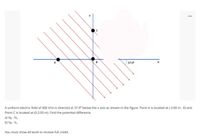
College Physics
11th Edition
ISBN: 9781305952300
Author: Raymond A. Serway, Chris Vuille
Publisher: Cengage Learning
expand_more
expand_more
format_list_bulleted
Concept explainers
Question

Transcribed Image Text:**Electric Field and Potential Difference**
A uniform electric field of 400 V/m is directed at 37.0° below the x-axis as shown in the figure.
- **Point A** is located at (-3.00 m, 0).
- **Point C** is located at (0, 3.00 m).
Find the potential difference:
a) \(V_B - V_A\)
b) \(V_B - V_C\)
**Diagram Explanation:**
The diagram contains a set of red parallel lines with arrows indicating the direction of the electric field, which slopes downward at a 37.0° angle below the horizontal x-axis. The y-axis is vertical. Points A, B, and C are marked as follows:
- Point A is on the x-axis at (-3.00 m, 0).
- Point B is on the origin (0,0).
- Point C is on the y-axis at (0, 3.00 m).
These points are marked by black dots on the graph.
**Note:** You must show all work to receive full credit.
Expert Solution
This question has been solved!
Explore an expertly crafted, step-by-step solution for a thorough understanding of key concepts.
This is a popular solution
Trending nowThis is a popular solution!
Step by stepSolved in 2 steps

Knowledge Booster
Learn more about
Need a deep-dive on the concept behind this application? Look no further. Learn more about this topic, physics and related others by exploring similar questions and additional content below.Similar questions
- Location A is 1.70 m to the right of a point charge q. Location B lies on the same line and is 5.40 m to the right of the charge. The potential difference VB-V₁-57.0 V. What is the magnitude and sign of the charge? TA Number i Units B B 1arrow_forwardPhysics Review Question #5arrow_forward13arrow_forward
- Image shows equation of electric field in x-y plane. b, a, a, and B are all constants. What would be the potential difference between the origin and a point y3Dy0 on the y axis? E(x,y)%3Dar²(y +a)î +B(x +b)y j х, уarrow_forwardA parallel plate, air filled capacitor, with plate of area A = 7.60 cm^2 and separated by a distance d = 1.80 mm, has a 20 V potential difference applied to its plates. Calculate: a) The electric field between the plates b) The surface charge density c) The capacitance d) The charge on each platearrow_forwardFive capacitors are connected as shown in the side figure. A potential difference of 12 V was applied between the 10 nF 15 nF ННН points a and c (AVac = 12 V). a) Calculate the equivalent capacitance between a and c b) Calculate the potential difference between a and b 25 nF ЧН c) What is the total charge on the circled combination 15 nF 10 nF of capacitors (10 nF and 15 nF). 3.arrow_forward
- 6)arrow_forwardWhat is the magnitude of the electric field at the point (2.90 i-7.20 j+5.50 k) m if the electric potential is given by V = 5.30xyz², where Vis in volts and x, y, and z are in meters? Number i Unitsarrow_forwardIn the figure, the charge q=0.880×10^−9C. A) Find the electric potential at x=0.450m Express your answer using appropriate units. B) Find the value of x between 0 and 1.00 m where the electric potential is zero. Express your answer using appropriate units.arrow_forward
- Q 7 pleasearrow_forwardThe figure represents two parallel-plate capacitors of capacitance C1 and C2 respectively connected as shown. C1=2 C2. A voltage is applied across the combination Connider the idowir Which of the two capacitors has the greatest potential difference between the plates? Ca O C1. O C2 the potential difference is the same O it depends on their charges. there is no way to know.arrow_forwardFor the following electric field: E(x,y) = (x² + y²)î + 2xyŷ Calculate the potential in the xy plane. Assume the potential at the origin equals to zero, meaning (0,0) = 0. Select one: a. 4(x,y) = 3 -2xy2 ○ b. x(x, y) = - - xy c. y(x, y): == -x³-xy² ○ d. 2:3 (x, y): = - +xy² 3 e. (x, y) = x3 + xy² ○ f. (x, y): - 3 xy2 ×arrow_forward
arrow_back_ios
SEE MORE QUESTIONS
arrow_forward_ios
Recommended textbooks for you
 College PhysicsPhysicsISBN:9781305952300Author:Raymond A. Serway, Chris VuillePublisher:Cengage Learning
College PhysicsPhysicsISBN:9781305952300Author:Raymond A. Serway, Chris VuillePublisher:Cengage Learning University Physics (14th Edition)PhysicsISBN:9780133969290Author:Hugh D. Young, Roger A. FreedmanPublisher:PEARSON
University Physics (14th Edition)PhysicsISBN:9780133969290Author:Hugh D. Young, Roger A. FreedmanPublisher:PEARSON Introduction To Quantum MechanicsPhysicsISBN:9781107189638Author:Griffiths, David J., Schroeter, Darrell F.Publisher:Cambridge University Press
Introduction To Quantum MechanicsPhysicsISBN:9781107189638Author:Griffiths, David J., Schroeter, Darrell F.Publisher:Cambridge University Press Physics for Scientists and EngineersPhysicsISBN:9781337553278Author:Raymond A. Serway, John W. JewettPublisher:Cengage Learning
Physics for Scientists and EngineersPhysicsISBN:9781337553278Author:Raymond A. Serway, John W. JewettPublisher:Cengage Learning Lecture- Tutorials for Introductory AstronomyPhysicsISBN:9780321820464Author:Edward E. Prather, Tim P. Slater, Jeff P. Adams, Gina BrissendenPublisher:Addison-Wesley
Lecture- Tutorials for Introductory AstronomyPhysicsISBN:9780321820464Author:Edward E. Prather, Tim P. Slater, Jeff P. Adams, Gina BrissendenPublisher:Addison-Wesley College Physics: A Strategic Approach (4th Editio...PhysicsISBN:9780134609034Author:Randall D. Knight (Professor Emeritus), Brian Jones, Stuart FieldPublisher:PEARSON
College Physics: A Strategic Approach (4th Editio...PhysicsISBN:9780134609034Author:Randall D. Knight (Professor Emeritus), Brian Jones, Stuart FieldPublisher:PEARSON

College Physics
Physics
ISBN:9781305952300
Author:Raymond A. Serway, Chris Vuille
Publisher:Cengage Learning

University Physics (14th Edition)
Physics
ISBN:9780133969290
Author:Hugh D. Young, Roger A. Freedman
Publisher:PEARSON

Introduction To Quantum Mechanics
Physics
ISBN:9781107189638
Author:Griffiths, David J., Schroeter, Darrell F.
Publisher:Cambridge University Press

Physics for Scientists and Engineers
Physics
ISBN:9781337553278
Author:Raymond A. Serway, John W. Jewett
Publisher:Cengage Learning

Lecture- Tutorials for Introductory Astronomy
Physics
ISBN:9780321820464
Author:Edward E. Prather, Tim P. Slater, Jeff P. Adams, Gina Brissenden
Publisher:Addison-Wesley

College Physics: A Strategic Approach (4th Editio...
Physics
ISBN:9780134609034
Author:Randall D. Knight (Professor Emeritus), Brian Jones, Stuart Field
Publisher:PEARSON